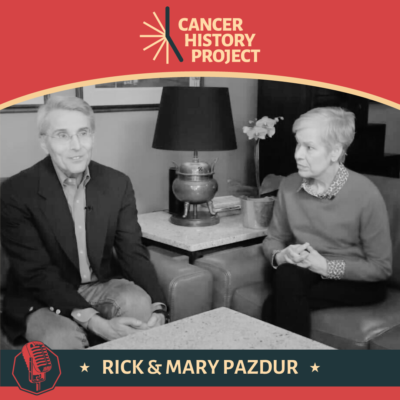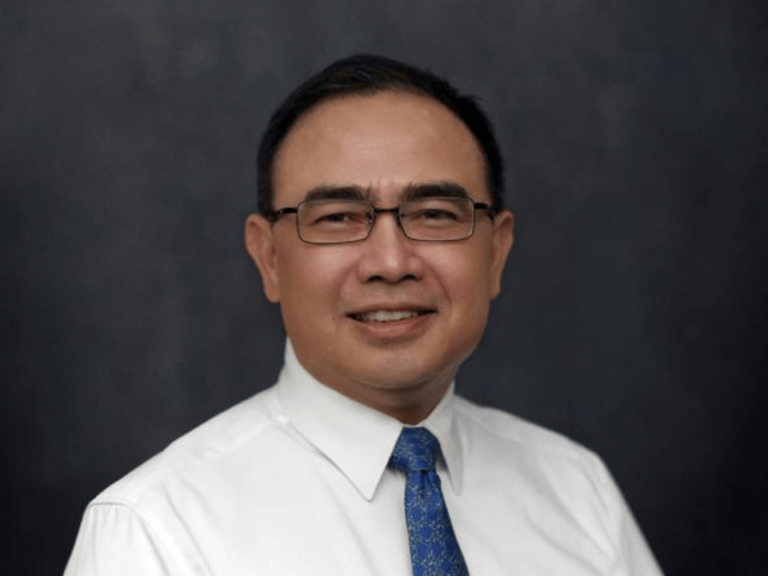

In 1999, Rick Pazdur went in for a “perfunctory” final interview at FDA. Thinking it would only take a few minutes, his wife, Mary, decided to wait and have a quick cup of coffee at a nearby restaurant—Hooters.
Five hours later, infamously, Mary was still waiting.
Rick got the job, and has spent over 25 years as FDA’s chief cancer strategist—starting as director of the FDA Office of Hematology and Oncology Products in 1999, and today serving as director of the FDA Oncology Center of Excellence as well as the acting director of the Office of Oncologic Diseases.
Mary, an oncology nurse practitioner, took a job at the NIH Clinical Center, where she worked for 16 years. Then, she was diagnosed with ovarian cancer.
This month on the Cancer History Project Podcast, listen to a 2015 interview with Rick and Mary Pazdur, recorded a few months before Mary died.
This episode is available on Spotify, Apple Podcasts, and YouTube.
This interview was conducted by Ellen Stovall, three-time cancer survivor and pioneering patient advocate, on behalf of the National Coalition for Cancer Survivorship. Stovall died a few months later—in January 2016—from cardiac complications due to her cancer treatments (The Cancer Letter, Jan. 8, 2016).
In this interview, the couple reflects on when cancer research gets personal, and how this perspective will continue to shape Rick’s career.
Rick and Mary met in June 1979, at Rush Presbyterian Hospital in Chicago. Mary Patricia Bagby was a nurse, and Rick was on the first day of his oncology fellowship.
“I always give the joke that our first date was over a bottle of Adriamycin in the exam room, which sounds somewhat peculiar, but that was the truth,” Rick said. “It was not over a bottle of chardonnay or whatever, but it gave us a common experience.”
I was always drawn to oncology because so many different diseases affecting so many body systems and developmentally along the continuum of life. And the silver lining is you learn a lot of existential lessons about living and dying when you’re almost too young to learn those things.
Mary Pazdur
The couple worked in parallel throughout their careers. “We worked at many of the same institutions in Chicago at Rush Presbyterian, St. Luke’s, in Detroit at Wayne State, and at MD Anderson,” Rick said in a recent interview (The Cancer Letter, Jan. 10, 2025).
Though they had very separate careers, having the ear of a nurse in the Clinical Center was instrumental when it came time to interview fellows who had rotated through the clinics, Rick said.
“Because, as everybody knows in clinical medicine, sometimes people could fool the attending physicians and other physicians,” he said. “But really the nurses on the floors and that are really taking care of the patients, they really understand who’s doing the work and who has the patient in mind and also the correct kind of clinical thinking and clinical judgment that is so important to what we do.”
After Mary’s diagnosis, their unique professional partnership had to evolve—from physician and nurse to caregiver and patient.
“You really have had a partnership in medicine before you became husband and wife and physician and patient,” Stovall said. “And it’s a distinctive, if not unique situation for a lot of people to witness how you manage to straddle both what you know professionally and what you’re experiencing personally.”
Mary credited her profession with preparing her for her diagnosis. She said:
I’ve always worked in oncology. Even when I was an undergraduate nursing student, I was always drawn to oncology because so many different diseases affecting so many body systems and developmentally along the continuum of life. And the silver lining is you learn a lot of existential lessons about living and dying when you’re almost too young to learn those things.
But I think it has prepared me in advance because many times I would be in an exam room with a patient as a healthcare provider wondering, I wonder how I would cope with that situation. What would I do? What would I think?
So, I’ve had the luxury of some rehearsal, and very few people have that opportunity in their lifetime, and it’s made it in some ways easier and respectful of that experience with those people. And you see also the strength and the resiliency of the human spirit that comes through.
Mary eventually took the therapies her colleagues at NCI had worked on. And when she needed an experimental drug on a clinical trial, she received a Compassionate Use authorization from FDA—a process Rick can now appreciate deeply from both sides.
Despite their access and leadership in the field, the couple insisted on not receiving any special treatment.
“We didn’t want to be treated any different than anybody else, because our experience has always been when people are treated differently, there always is mistakes, there’s always irrational decisions,” Rick said. “I don’t want anything special. I don’t want you moving up appointments. I don’t want to be getting in front of anybody for a CT scan or having Mary get in front of anybody. All I wish is just to be treated as a patient.”
The experience fundamentally reshaped both of their perspectives.
“I identify now with my fellow patients versus being a nurse,” Mary said. “And that’s been a transition that very slowly has evolved and it’s been a positive one. I think what I found again is that patients should support each other and help each other and get through and have tips and insights and just many, many things. And I don’t think I underestimated the importance of that role of having a peer support group, but I valued it much more now being on this side.”
At a conference not long after this interview was conducted, Rick said, “This three-year period of time has given us the opportunity for observation of the healthcare system from the other side of the stethoscope. You see the worst of the system; you see the fact that you’re not immune just because you’re a doctor or a member of a doctor’s family.”
Mary died in December 2015 (The Cancer Letter, Dec. 4, 2015).
Recalling the infamous Hooters incident 25 years later, Rick said:
I already had, kind of, the job, and I just had to do my last interview with Janet Woodcock.
And so, we had come to look at homes also, because this was during the recruiting process. Mary and I were driving together and I said, “Mary, why don’t you just go, just have a cup of coffee at Hooters. I’m just going to be five minutes, and then we’re on our way. This is just a kind of perfunctory visit that I have to play here.”
What happened was that there was a snafu in Janet Woodcock’s calendar, so this 15-minute conversation lasted—well, the conversation didn’t last—my waiting for her lasted three or four hours.
So, by the time I got out of the FDA offices, it was almost five hours that my late wife was sitting in Hooters, and she said, “I’m going to kill you over this. Do you know how many guys came and tried to hit me up, so to speak, with me just sitting five hours in this restaurant with one cup of coffee?”
That kind of got off at a bad start, but the rest of it was positive.
Read more on the Cancer History Project. This interview is available on Spotify, Apple Podcasts, and YouTube.
Related articles in The Cancer Letter
- After 25 years at FDA, Richard Pazdur reflects on opportunities for change at the agency, Jan. 10, 2025
- At his 25-year “anniversary party,” Pazdur invites Califf and past FDA commissioners to talk about political interference, Nov. 1, 2024
- Mary Pazdur, 63, Dies of Cancer; What Her Husband Has Learned, Dec. 4, 2015
- Rick’s Search for Meaning, Dec. 4, 2015
- Pazdur: “The Primary Endpoint of Any Trial Should be the Patient.”, Oct. 23, 2015
The Cancer History Project is a free, collaborative archive of oncology history that aims to engage the scientific community and the general public in a dialogue on progress in cancer research and discovery.
This project is made possible with the support of our sponsors: the American Society of Clinical Oncology, the University of Texas MD Anderson Cancer Center, ACT for NIH, UK Markey Cancer Center, Rutgers Cancer Institute of New Jersey/RWJBarnabas Health, The University of Kansas Cancer Center, and the National Comprehensive Cancer Network.
The Cancer History Project is an initiative of The Cancer Letter, and is backed by 60 partners, spanning academic cancer centers, government agencies, advocacy groups, professional societies, and more.
Interested in learning more about the history of oncology? Subscribe to our monthly podcast on Spotify or Apple Podcasts.










